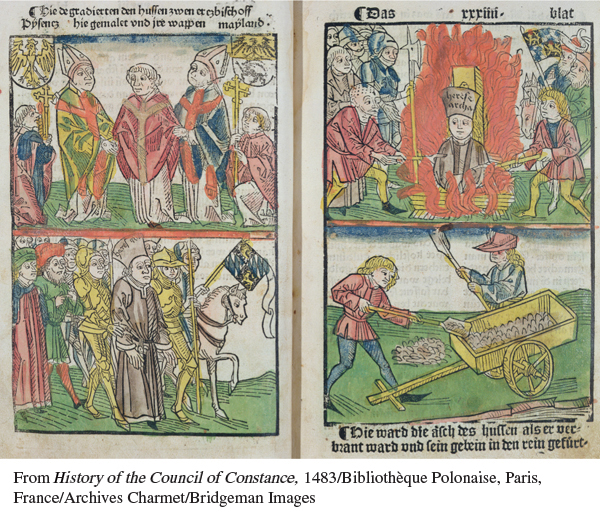Critiques, Divisions, and Councils
Criticism of the church during the Avignon papacy and the Great Schism often came from the ranks of highly learned clergy and lay professionals. One of these was William of Occam (1289?–1347?), a Franciscan friar and philosopher who predated the Great Schism but saw the papal court at Avignon during the Babylonian Captivity. Occam argued vigorously against the papacy and also wrote philosophical works in which he questioned the connection between reason and faith that had been developed by Thomas Aquinas (see Chapter 10). All governments should have limited powers and be accountable to those they govern, according to Occam, and church and state should be separate.
The Italian lawyer and university official Marsiglio of Padua (ca. 1275–1342) agreed with Occam. In his Defensor Pacis (The Defender of the Peace), Marsiglio argued against the medieval idea of a society governed by both church and state, with church supreme. Instead, Marsiglio claimed, the state was the great unifying power in society, and the church should be subordinate to it. Church leadership should rest in a general council made up of laymen as well as priests and superior to the pope. Marsiglio was excommunicated for these radical ideas, and his work was condemned as heresy — as was Occam’s — but in the later part of the fourteenth century many thinkers agreed with these two critics of the papacy. They believed that reform of the church could best be achieved through periodic assemblies, or councils, representing all the Christian people. Those who argued this position were called conciliarists.

The Hussite Revolution, 1415–1436
The English scholar and theologian John Wyclif (WIH-klihf) (ca. 1330–1384) went further than the conciliarists in his argument against medieval church structure. He wrote that the Scriptures alone should be the standard of Christian belief and practice and that papal claims of secular power had no foundation in the Scriptures. He urged that the church be stripped of its property. He also wanted Christians to read the Bible for themselves and produced the first complete translation of the Bible into English. Wyclif’s followers, dubbed Lollards, from a Dutch word for “mumble,” by those who ridiculed them, spread his ideas and made many copies of his Bible. Lollard teaching allowed women to preach, and women played a significant role in the movement. Lollards were persecuted in the fifteenth century; some were executed, some recanted, and others continued to meet secretly in houses, barns, and fields to read and discuss the Bible and other religious texts in English. Bohemian students returning from study at the University of Oxford around 1400 brought Wyclif’s ideas with them to Prague, the capital of what was then Bohemia and is now the Czech Republic. There another university theologian, Jan Hus (ca. 1372–1415), built on them. He also denied papal authority, called for translations of the Bible into the local Czech language, and declared indulgences — papal offers of remission of penance — useless. Hus gained many followers, who linked his theological ideas with their opposition to the church’s wealth and power and with a growing sense of Czech nationalism in opposition to the pope’s international power. Hus’s followers were successful at defeating the combined armies of the pope and the emperor many times. In the 1430s the emperor finally agreed to recognize the Hussite Church in Bohemia, which survived into the Reformation and then merged with other Protestant churches.
The ongoing schism threatened the church, and in response to continued calls throughout Europe for a council, the cardinals of Rome and Avignon summoned a council at Pisa in 1409. That gathering of prelates and theologians deposed both popes and selected another. Neither the Avignon pope nor the Roman pope would resign, however, and the appalling result was the creation of a threefold schism.
Finally, under pressure from the German emperor Sigismund, a great council met at the imperial city of Constance (1414–1418). It had three objectives: to wipe out heresy, to end the schism, and to reform the church. Members included cardinals, bishops, abbots, and professors of theology and canon law from across Europe. The council moved first on the first point: despite being granted a safe-conduct to go to Constance by the emperor, Jan Hus was tried, condemned, and burned at the stake as a heretic in 1415. The council also eventually healed the schism. It deposed both the Roman pope and the successor of the pope chosen at Pisa, and it isolated the Avignon pope. A conclave elected a new leader, the Roman cardinal Colonna, who took the name Martin V (pontificate 1417–1431).

The Arrest and Execution of Jan Hus In this woodcut from Ulrich of Richental’s chronicle of the Council of Constance, Hus is arrested by bishops, led away by soldiers while wearing a hat of shame with the word “arch-heretic” on it, and burned at the stake. The final panel shows executioners shoveling his ashes and burned bones into the Rhine. Ulrich of Richental was a merchant in Constance and an eyewitness to Hus’s execution and many of the other events of the council. He wrote his chronicle in German shortly after the council ended and paid for it to be illustrated. The original is lost, but many copies were made later in the fifteenth century, and the volume was printed in 1483 with many woodcuts, including this one. Hus became an important symbol of Czech independence, and in 1990 the Czech Republic declared July 6, the date of his execution in 1415, a national holiday.
(From History of the Council of Constance, 1483/Bibliothèque Polonaise, Paris, France/Archives Charmet/Bridgeman Images)
Martin proceeded to dissolve the council. Nothing was done about reform, the third objective of the council. In the later part of the fifteenth century the papacy concentrated on Italian problems to the exclusion of universal Christian interests. But the schism and the conciliar movement had exposed the crying need for ecclesiastical reform, thus laying the foundation for the great reform efforts of the sixteenth century.

